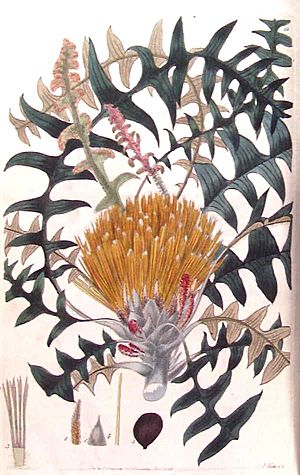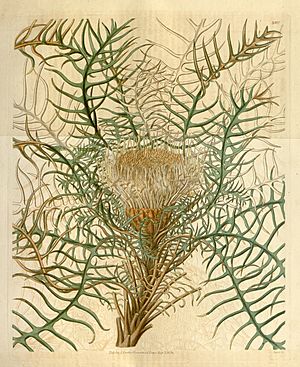Dryandra ser. Aphragma facts for kids
Dryandra ser. Aphragma was once a group of plants within the Dryandra genus. Think of it like a specific team within a larger sports club. This group is now considered "obsolete," which means it's no longer used in the way scientists classify plants today.
The plants that were in Dryandra are now part of the Banksia genus, specifically in a group called Banksia ser. Dryandra. This change happened in 2007, when scientists Austin Mast and Kevin Thiele decided to combine Dryandra into Banksia.
Contents
How Robert Brown Classified These Plants
The First Grouping of Aphragma
In 1830, a botanist named Robert Brown first described Aphragma. He organized Dryandra plants into three main groups. He looked at how many "seed separators" (small barriers inside the seed pods) each plant had.
Brown's group, D. sect. Aphragma, included four species that he believed had no seed separators. The name Aphragma comes from Greek words meaning "without a barrier."
Here are some of the plants Brown placed in this group, and what they are called today:
- D. nervosa (now B. alliacea)
- D. callophylla (now B. calophylla)
- D. pteridifolia (now B. pteridifolia)
- D. blechnifolia (now B. pellaeifolia)

How Carl Meissner Changed the Group
Adding More Plants to Aphragma
In 1856, another scientist named Carl Meissner reviewed Brown's work. He kept Brown's three main groups, including D. sect. Aphragma.
Meissner made a few small changes to the Aphragma group:
- He moved D. blechnifolia to be a type of D. pteridifolia.
- He added a new plant, D. drummondii (now B. drummondii), which had been discovered later.
So, Meissner's Aphragma group looked very similar to Brown's, but with these small updates.
How George Bentham Redefined Aphragma
A New Way to Define the Group
In 1870, George Bentham also kept the Aphragma group. He was the only one to keep this specific grouping from Meissner's work.
Bentham had a different idea about the seed separators. He thought that in some plants, the seed coats didn't join together properly. This meant that plants with no visible seed separators, like those in Aphragma, or those with two plates, were actually similar.
Because of this new idea, he moved D. bipinnatifida into the Aphragma group. He said that plants in Aphragma had "outer coverings of the two seeds not joined or easily separated." He also noticed that plants in this group had large, wide bracts (leaf-like structures near the flowers), which made them look different from other Dryandra species.

Here are some plants Bentham included in his Aphragma group:
- D. tenuifolia (now B. tenuis)
- D. proteoides (now B. proteoides)
- D. runcinata (now B. rufa subsp. rufa)
- D. obtusa (now B. obtusa)
- D. bipinnatifida (now B. bipinnatifida)
- D. pteridifolia (now B. pteridifolia)
- D. calophylla (now B. calophylla)
Bentham's classification was used for over a hundred years!
How Alex George Changed the Rank
From Section to Series
In 1996, Alex George changed D. sect. Aphragma from a "section" to a "series." This is like changing a major division into a slightly smaller, more specific group within the genus. He didn't use the old definitions based on seed separators. Instead, he looked at many different features of the flowers, seeds, and leaves.

Here are some of the plants that were part of George's D. ser. Aphragma group:
- D. pteridifolia (now B. pteridifolia)
- D. fililoba (now B. fililoba)
- D. shanklandiorum (now B. shanklandiorum)
- D. nervosa (now B. alliacea)
- D. blechnifolia (now B. pellaeifolia)
- D. porrecta (now B. porrecta)
- D. aurantia (now B. aurantia)
- D. calophylla (now B. calophylla)
- D. lepidorhiza (now B. lepidorhiza)
Why the Classification Changed Again
Modern DNA Science and New Discoveries
Since 1998, scientists like Austin Mast have been using DNA information to study how plants are related. Their research showed that the Dryandra genus actually grew out of the Banksia genus. This means that Dryandra wasn't a completely separate group, but rather a part of Banksia.
Because of this strong evidence from DNA, Mast and Kevin Thiele decided in 2007 to combine Dryandra into Banksia. This meant that all the old groupings within Dryandra, including D. ser. Aphragma, were no longer used. Now, all these plants are simply part of Banksia ser. Dryandra. Scientists continue to study the DNA of these plants to create the most accurate family tree for them.

